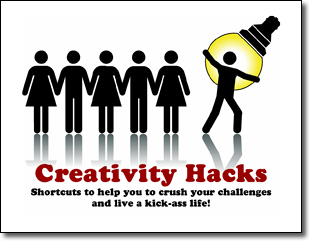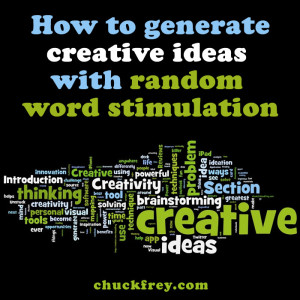Random word stimulation is a powerful brainstorming technique that can help you access your subconscious mind and the wealth of information it contains to generate original ideas.
Regular practice causes the brain to expand its neural network to accommodate this free-form style of brainstorming, which strengthens connection to the subconscious mind and endows the practitioner with greatly enhanced creativity and critical thinking skills.
The best part? The benefits of improving your thinking skills come from the practice of brainstorming new ideas about things that matter to you. Using this simple technique, you can find new ways to solve personal or business problems, create new inventions, improve existing products and services, explore your own feelings and your relationships with others, and – in the larger sense – to discover new ways of thinking about absolutely anything that interests you.
Before you begin using this brainstorming technique, you will need a printed dictionary. Not a dictionary on your computer – an actual old-fashioned “analog” book. You will also need a way to take notes – a pen and paper or computer are fine.
Step 1: Formulate a specific problem statement
Write down exactly what it is you want to brainstorming new ideas about. You can work with any type of subject, there are no limitations. Try to capture the true essence of what you’re looking for in as few words as possible. Be specific in your description, a vague description will usually yield equally vague results.
The subject can be stated in the following forms:
- Solve a Problem – State the problem to solve. Defining a problem is an art in itself. A clear perception of the problem is the first step toward discovering an optimal solution.
- Generate Ideas – State what the new ideas are about. Perhaps to create a new invention of some kind, improve an existing product or service, or simply to gain a deeper insight into any subject.
- Ask a Question – It’s amazing how answers can present themselves with the help of some random stimulation – answers that come from the same mind that asked the question!
Step 2: Gather random stimuli
Close your eyes. Open the dictionary to any page and place your finger on the page. Open your eyes and write down whatever word is closest to your finger. It’s very important to use that particular word whether you like the word or not. This technique works best when there is no obvious relationship between the word and your subject. Don’t choose the word – let the word choose you.
Randomness is critical so use whatever word you point to, write it down, and don’t let your eyes wander over the page. Of course it’s a good idea to read the definition so you understand the full meaning of the word.
Repeat this procedure to select five or six random words from different pages in the dictionary.
Step 3: Create associations between random words, your challenge
At this point you have reached the critical juncture that will determine your level of success in using the Random Word Stimulation brainstorming technique.
Your objective is to brainstorm associations that connect the meaning of each random word to your subject in some way. Each new association represents the seed of a new idea so the more associations you create, the better your chances of generating useful results.
Exposure to the stimulus of random words will immediately trigger associations to experiences buried in your subconscious mind. The process is automatic and inevitable. Many associations and the ideas they generate will not make sense in relation to your subject. Be aware that new ideas often seem illogical, absurd, or completely irrelevant when they first come into your mind.
Our minds have been trained to make sense of things. Thoughts that do not make sense trigger a deeply conditioned Left-Brain response of instantly discarding these thoughts as worthless fantasy. Learning to recognize this conditioned response and bring it under managed control is essential. Catch the moment when you think “This Does Not Make Sense” and turn it into a question of “How Could This Make Sense?”
It’s the effort you make to answer this question that causes the brain to respond. Exercising the body results in increased strength and enhanced capabilities of movement. Exercising the brain through brainstorming results in increased mental strength and enhanced capabilities of thinking.
It does not matter if your associations make sense logically or not at this point. Find any way to connect the words to your subject that you can think of. If you feel inhibited in any way make an effort to be a little outrageous until you overcome your inhibitions. Did I say “a little”? No – what I meant to say was extremely outrageous!
Focus on brainstorming as many new ideas as possible. Do not stop to justify your new ideas, for now it is enough that you have them. Have faith in the fact that your subconscious mind brought these thoughts to light for a reason, even though the reason may not be readily apparent. Success depends entirely on your willingness to temporally suspend the urge to discard new ideas and allow yourself the freedom to explore them.
Step 4: Increase your associations
It was Aristotle (384 – 322 BC) that formulated the three laws of association. Apply these laws in as many ways as you can to create your associations. They are:
- Contiguity: This law explains how associations work by the stimulation of contact or nearness. A saddle may remind you of a horse, a tree of a forest, a foot of a shoe.
- Similarity: This law explains how similar things produce associations. A cat could remind you of a tiger, a tent may provoke the association with a log cabin, the human eye is similar to a camera, a stair is similar to an escalator.
- Contrast: This law explains how we associate things that contrast one another. A dwarf may trigger associations of a giant, day is a contrast to night, a sad face is a contrast to a happy face, black and white are contrasting colors, tall and short, new and old, fresh and stale.
Take some time to consider each word individually and in combination. Be sure to write down everything that comes into your mind, no matter how silly or irrelevant they may seem at first.
Step 5: Make more connections
Congratulations! You have just expanded your perceptions of your subject far beyond your normal patterns of thinking in ways you would not have otherwise considered.
After a number of new associations have been generated, perhaps several dozen, you can begin to explore and discover ways to apply your associations to the matter at hand. Applying random meaning to a subject suggests ways of looking at the subject in a different context from which the subject is normally viewed. Discovering new ways to look at your subject will start to generate new ideas automatically.
Just remember that brainstorming new ideas is about quantity rather than quality. It’s like drilling for oil. You will often drill many dry holes before you finally hit the gusher that brings the fortunes of success.
Keep in mind that due to our education, and the many other influences in our world, most of us lean toward left-brained, logical thinking. Random Word Stimulation is by nature a decidedly right-brain activity. Depending on your current brain state balance, you may find Random Word Stimulation awkward to use at first. This is why it is highly recommend to limit your initial sessions to 10 to 15 minutes to avoid frustration.
The brain can take a few days or more to restructure its neural network to accommodate this new type of thinking. If you are having trouble getting started, don’t worry about it. Just keep trying short, relaxed sessions until you acquire the habit of producing results. Remember it’s the effort of trying that triggers the brain to adjust and it will adjust if you give it the time and patience it needs.
This article was originally published on InnovationTools.com
 Creativity Hacks will inspire you to explore in new places, to make new connections, to dig deeper and discover new insights. It will help you to seek out new knowledge and sources of inspiration - so you can profit from the opportunities all around you. When you're done reading Creativity Hacks, you'll be:
Creativity Hacks will inspire you to explore in new places, to make new connections, to dig deeper and discover new insights. It will help you to seek out new knowledge and sources of inspiration - so you can profit from the opportunities all around you. When you're done reading Creativity Hacks, you'll be:
- Empowered to solve problems and tackle challenges head-on.
- Able to see ideas and opportunities everywhere.
- Able to differentiate yourself and advance your career faster.
Above all, you'll learn that creativity is a skill YOU can cultivate!

